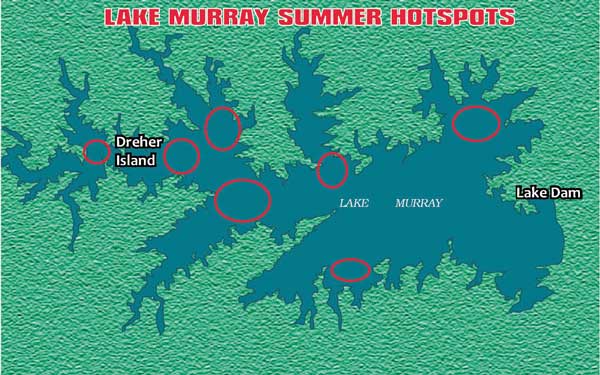
Cover the right kind of deep water, and you can fill your cooler with Lake Murray’s finest crappie.
Spring marks the peak of the annual mating ritual for a majority of freshwater gamefish species in South Carolina, with the almighty crappie being one of the first to rush into the stump-laden shallows. For many fishermen, the season for catching slab crappie comes to an end just as schools of fish retreat to deeper waters.
Often perceived as a shallow-water gamefish, crappie are predominantly a deep-water species that frequents the shallows for only a short duration in the early spring. Crappie spend the majority of the year in temperature-stable waters, cruising the edges of creek channels, ambushing suspended schools of baitfish and hovering over brushpiles.
This postspawn period is commonly referred to as the “replenishment phase” of a crappie’s annual life cycle. The stresses of mating deplete their energy reserves, increasing the intensity of their daily feeding rituals once it’s over.
Crappie fishing during the postspawn can be quite productive, but it’s often overlooked by many anglers switching over to bluegill and largemouth bass as the waters warm.
South Carolina’s lakes are loaded with healthy populations of crappie, with Lake Murray well known as one of the state’s top crappie destinations. Its 50,000-acre collaboration of deep and shallow areas littered with natural cover and boat docks makes it a prime spot to catch summer slabs.
The key to landing a stringer full of summer slabs is a real possibility using a few techniques well understood by guide Brad Taylor of Lake Murray’s Taylor Outdoors, who considers crappie one of his specialties. He is well-educated on where summer slabs are hiding and what techniques are successful for bringing home a heavy stringer full of summer specks.
“During the postspawn on Murray, crappie move back into deeper waters and are usually found along the edges of drop-offs, near points on the main lake and along the creek channels,” he said.
While crappie are quite predicable every spring, the summer pattern can be variable, and knowing where to find fish can be challenging. Crappie become nomadic during the summer, but their first big move is from their spawning grounds to the deep waters of the main lake or the mouth of their home creek, where they hover over deep brushpiles.
Finding key locations begins with an accurate topographic map and a good depthfinder.
“The most valuable piece of equipment on my boat, no matter what time of year, is my sonar,” Taylor said. “You have to be able to find the fish to catch them, but you must know how to read it to understand what you’re looking at.”
Taylor’s targets the drops on the edge of the channel near creek mouths, continuously watching his Hummingbird 997 to mark fish or structure. Over the last decade, companies have drastically improved technology, producing unbelievably clear, accurate, and highly sophisticated units that give fishermen the best look possible below the water’s surface. Taylor recommends choosing higher-grade units to give more accurate detail and an overall better picture of what lies beneath.
Taylor searches for fish and pays close attention to the surroundings, depths and proximity to structure when he finds them.
“Summer crappie move around a lot, and you cannot depend on one spot. But once you find them, the pattern will be dependable and reproducible,” he said.
Even during the summer, crappie remain communal, but they will frequent locales in smaller schools. Fortunately for fishermen, crappie remain in schools for most of the year. Once a fish is caught, several others will be close by.
Taylor typically locates Lake Murray crappie during the summer in 20 to 25 feet of water. They will be suspended anywhere within the water column, depending on the time of day and clarity of the water. As a rule, the better fish can see, the deeper they’ll be. On bluebird days, they will be close the bottom, holding tight to structure, during the middle of the day. But they’ll stage higher in the water column earlier and later.
Typically, summer successes develop from dawn through the first couple of hours of daylight. Taylor starts off his summer trips early to take advantage of the early bite.
While the fishing techniques and tackle boxes of bass fishermen will vary tremendously, crappie fishermen can keep it fairly simple with minnows and jigs.
Mark Danque of Chapin is an avid crappie fishermen who competes in more than 20 tournaments per year on the Southern Crappie Tournament Trail or Bass Pro Shops Crappie Masters circuit. He has been fishing competitively for crappie for more than 20 years, and his Lake Murray tackle shop, The Crappie Hole, is centered on slabs.
His summer techniques are quite simple. He slow-trolls jigs tipped with shiner minnows over deep brushpiles along ledges and creek channels. Often referred to as “spider-rigging” or “tight-lining,” Danque’s method produces some great catches as the summer heats up.
He uses a Carolina-rig set up with a half-ounce egg sinker and 18-inch leader of 6-pound mono attached to a 1/16th-ounce jighead. Colors are typically dependent on the lake conditions and water clarity, and Danque will try different colors on several rods to see which colors work best.
“I get the best results from using light-colored jigs in clear water and dark-colored jigs in darker water,” said Danque, who positions his boat over brushpiles at 20 and 30 feet but will dangle lures 10 to 12 feet above the cover. Fish are typically feeding in the brush or suspended just above.
“Early in the morning, the crappie will be closer to the surface, and we generally fish shallower early and deeper as the sun rises higher,” Danque said.
Danque and Taylor catch crappie all over the lake throughout the year, but the summertime fish tend to be more concentrated in the central portion of the lake, in the vicinity of Dreher Island.
The majority of fishermen only enroll in the spring mating fiasco, dropping minnows in the stump laden shallows. Following a few techniques and practice on the water, crappie fishing at Lake Murray can be explosive extending the slab-fest into the summer months.

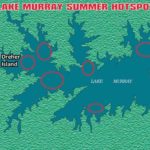
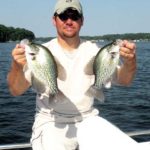
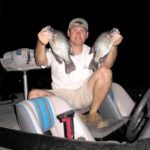
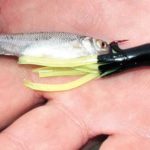
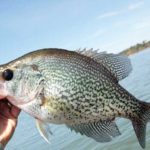
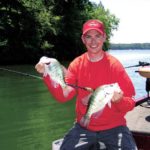



Be the first to comment